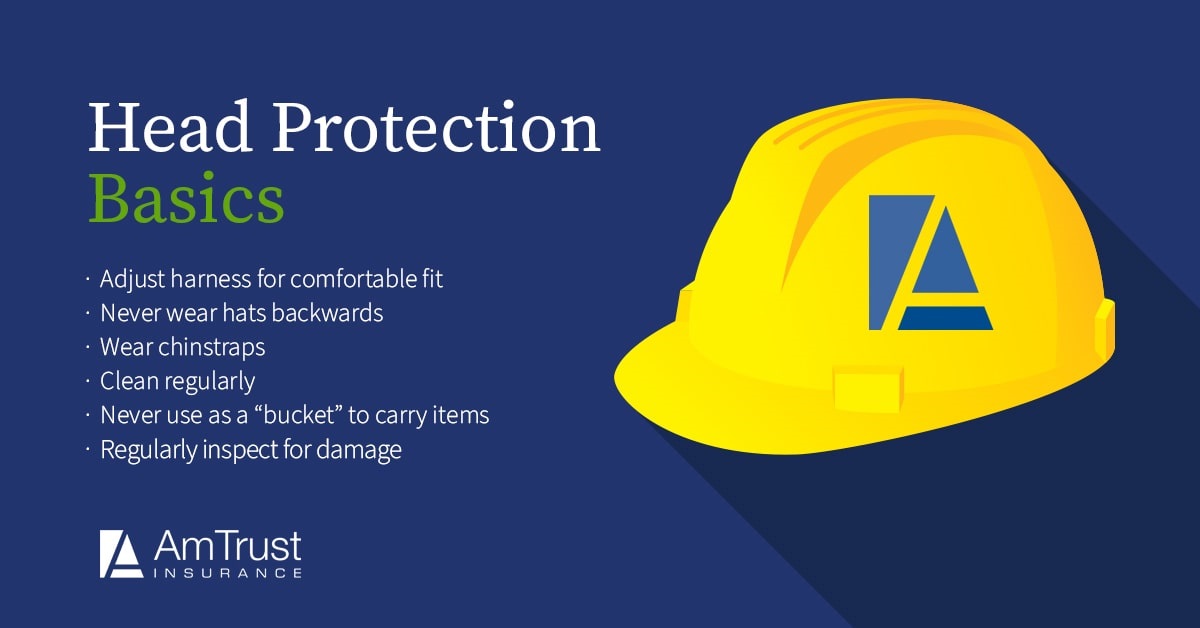Summary: Providing proper head protection for employees is essential to help reduce head injuries like traumatic brain injuries and fatalities at job sites. Learn more about the types and classes of hard hats and how this personal protective equipment plays an important role in keeping workers safe. The Importance of Proper Head Protection for Employees
Many employees work in hazardous situations, exposed to risks where they could injure a very important part of their bodies: their heads. For instance, employees
working in a warehouse with items stacked high up on shelves, those who do
tree trimming, construction workers who
climb scaffolding, or those working near overhead electrical lines are all in danger of encountering hazards to their heads.
Protecting the human head is vital to keeping workers safe on the job. The head and brain are sensitive and easily susceptible to injuries due to impact from falling objects, collisions and bumps. Many nonfatal workplace accidents are due to head injuries. The Bureau of Labor Statistics (BLS) reports that in 2020, there were over
68,000 reported cases of head injuries in all industries, including traumatic brain injuries (TBI). According to the CDC, TBIs are common occupational injuries that account for
20-25% of work-related trauma. Severe traumatic brain injuries may not only result in permanent disability, but they may also impact a worker’s ability to return to work. TBIs can also be expensive for employers due to lost productivity and long-term rehabilitation costs.
Head Protection: Classes of Hard Hats

Hard hats are most often associated with protecting employees on job sites from falling objects. However, they can do a great deal more for head protection. Hard hats can also protect workers from shock or burns caused by contact with live electric lines, cuts from falling or flying objects, and help keep hair from getting caught in moving parts of machinery.
However, before purchasing hard hats, employers should understand which types will help eliminate or minimize the specific hazards facing their workers. For instance, do employees need overhead protection from falling objects when operating bulldozers? Are they working near electric lines with the possibility of the line contacting their heads? A safety equipment supplier can help employers select the most appropriate type of hard hat to ensure workers are protected on the job, but it’s also important to know some head protection basics.
OSHA Standard 1910.135 provides the general requirements for head protection in the workplace. The best head protection should help resist blows to the head, absorb impact and insulate from shocks. Hard hats come in many types and are an essential part of personal protective equipment (PPE) for employees.

Hard hats are rated by the following types and classes:
- Type 1: Type 1 hard hats help reduce the force of impact to the top of the head, such as tools falling from above. They have a full brim that encircles the hat.
- Type 2: Type 2 hard hats are designed to help reduce the force of an impact to the front, sides, back, and top of the head, such as colliding with the side of a steel beam on a construction site. They have short bills on the front.
- Class G (General): Class G hard hats protect against the impact of falling objects and electric shock from contact with low voltage currents.
- Class E (Electrical): Class E hard hats protect against the impact of falling objects and electric shock from high voltage currents.
- Class C (Conductive): Class C hard hats only protect against the impact of falling objects; they provide no protection against contact with electrical conductors.
- Bump caps: Bump caps are designed only to protect workers from injury if their head strikes an object, such as overhead pipes or beams. They do not protect against the impact of falling objects.
When considering head protection for workers, make sure to consider the types of hazards they face, along with the OSHA Standard. It’s also important to consider other types of PPE employees may need to wear along with the hard hat, such as goggles, respirators or ear muffs, to ensure the hard hat does not interfere with them. Some hard hats may have these items built in for convenience. Workers utilizing hard hats in extreme weather conditions may need additional protection, such as sweatbands for hot areas and insulated hoods or caps for cold locations.
Employee Safety Training for Head Protection and Proper Hard Hat Use

Ongoing training to ensure hard hats are being used correctly is essential to employee safety. Some basic head protection training includes:
- Understanding how to wear a hard hat correctly – never wear them backward like a baseball cap
- Knowing how to properly adjust harnesses inside for a comfortable fit that holds the hat in place
- Wearing chinstraps to help hold the hard hat in place when working in awkward positions
- Cleaning hard hats according to the manufacturer’s specifications, as some cleaning solvents may weaken them
- Never using the hard hat as a “bucket” to carry items around the job site
- Inspecting the hard hat for damage regularly and removing and replacing any hard hat that’s been damaged
Employers should correctly wear hard hats when needed to not only set an example for their workers, but also to stay protected themselves.
Safety Resources from the AmTrust Loss Control Department
The AmTrust
Loss Control department specializes in risk management solutions to prevent injuries and improve employee safety. We help businesses take a proactive approach to reducing workplace accidents, identifying specific hazards and offering solutions that fit the organization’s specific needs. We even offer
Virtual+ Loss Control services, leveraging mobile technology to perform worksite inspections and tour policyholders’ facilities remotely in real time. To learn more about our loss control services, please
contact us today.
 This material is for informational purposes only and is not legal or business advice. Neither AmTrust Financial Services, Inc. nor any of its subsidiaries or affiliates represents or warrants that the information contained herein is appropriate or suitable for any specific business or legal purpose. Readers seeking resolution of specific questions should consult their business and/or legal advisors. Coverages may vary by location. Contact your local RSM for more information.
This material is for informational purposes only and is not legal or business advice. Neither AmTrust Financial Services, Inc. nor any of its subsidiaries or affiliates represents or warrants that the information contained herein is appropriate or suitable for any specific business or legal purpose. Readers seeking resolution of specific questions should consult their business and/or legal advisors. Coverages may vary by location. Contact your local RSM for more information.